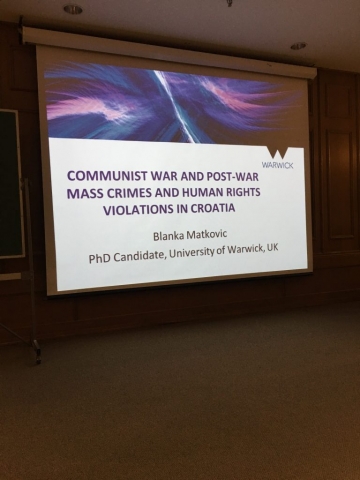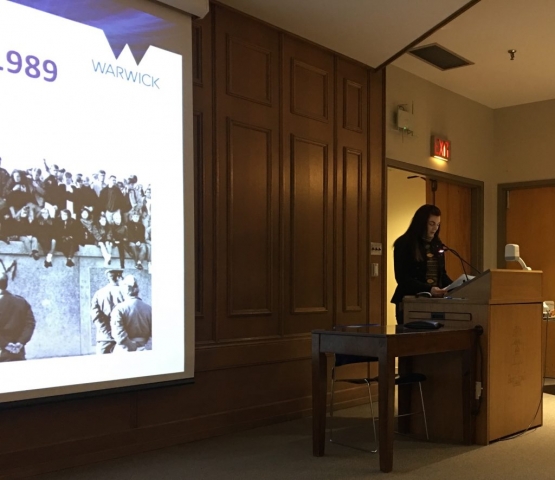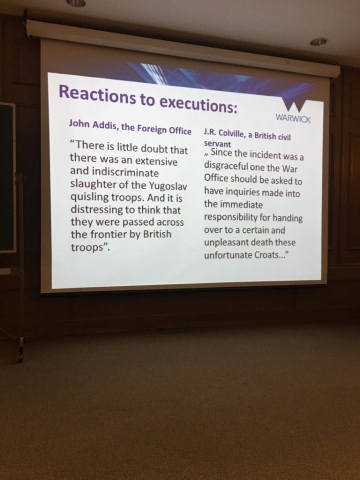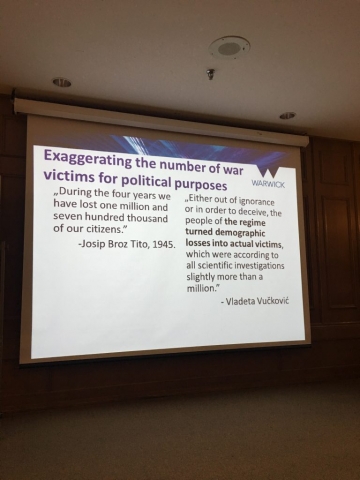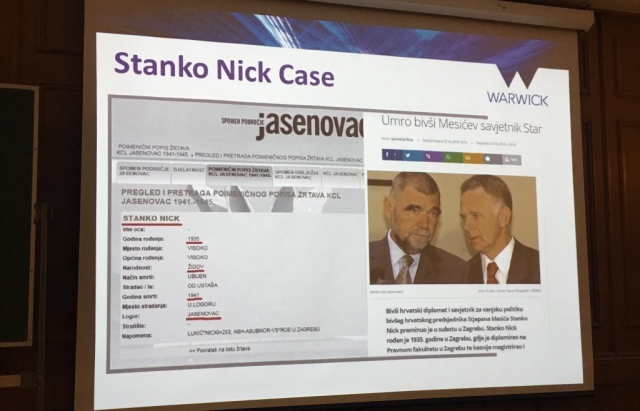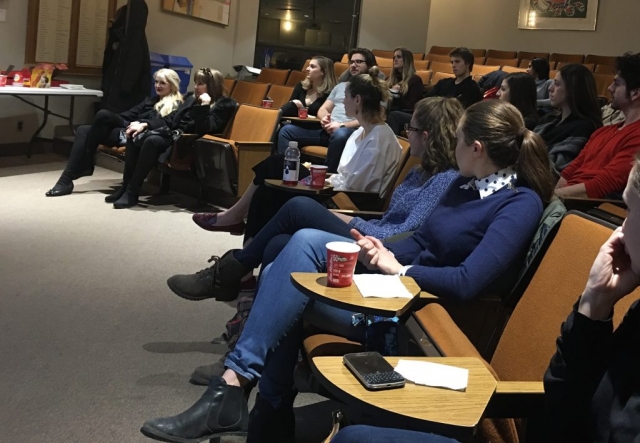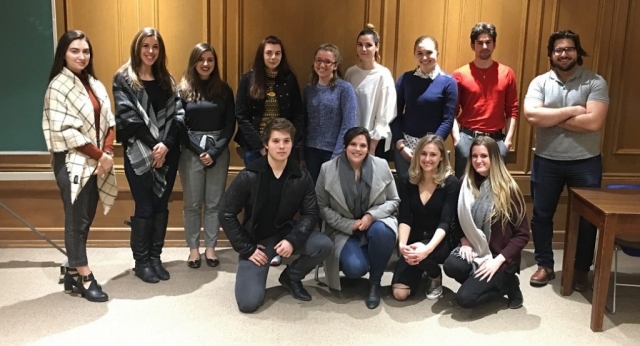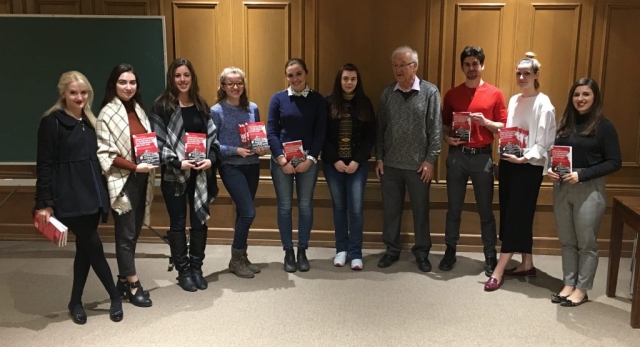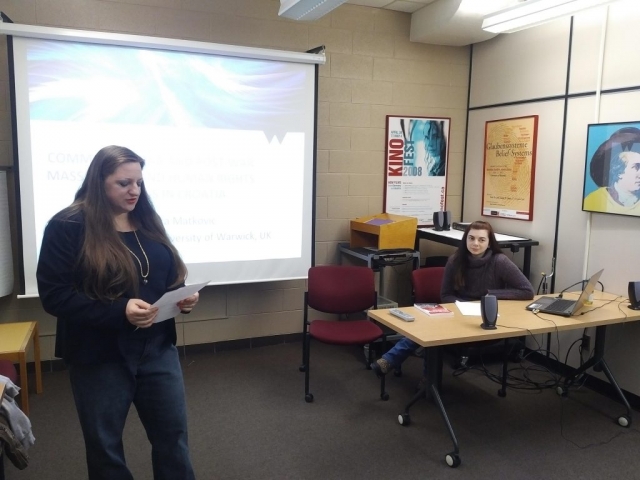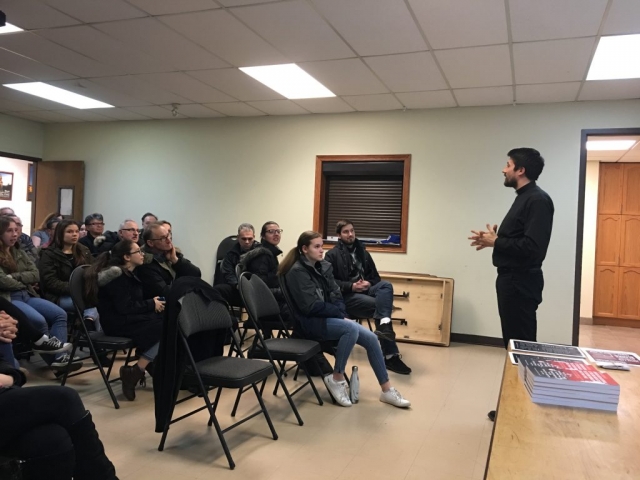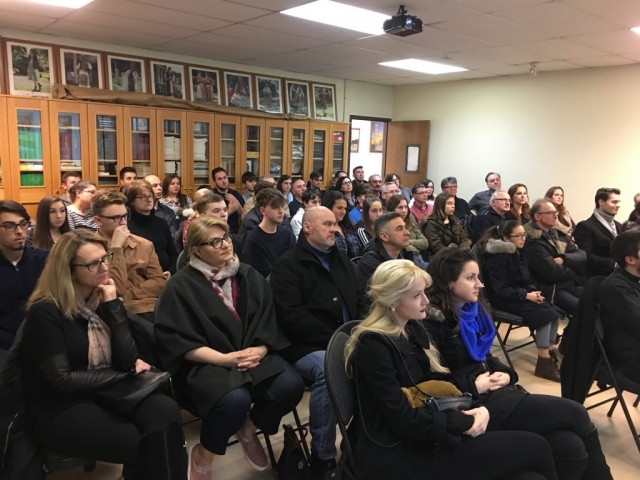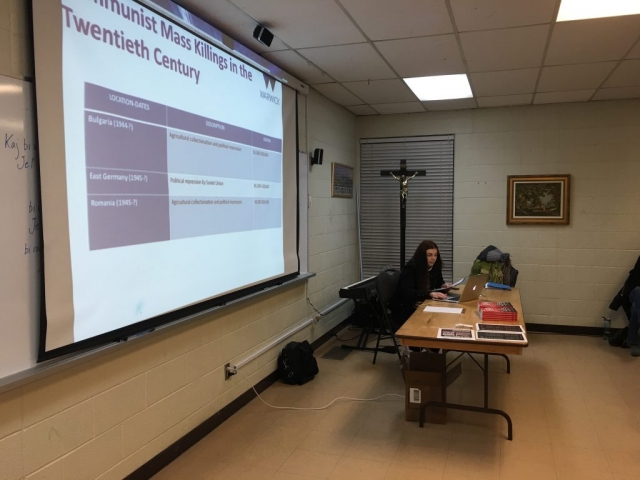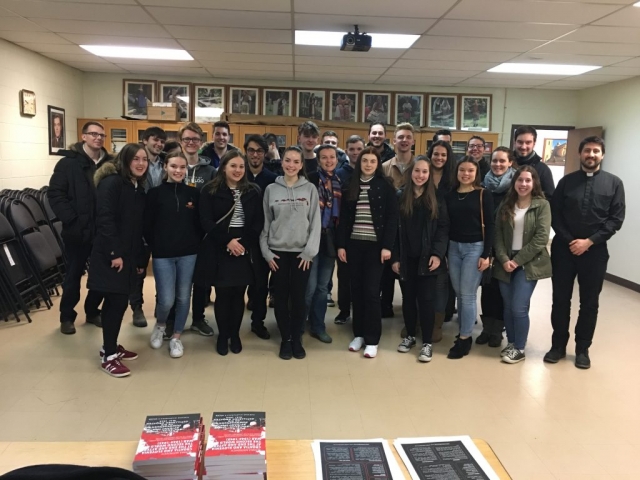
Na fotografiji: Studenti iz Croatian Student Association – University of Toronto s Blankom Matković
Predavanje Blanke Matković koje objavljujemo na našoj web stranici održano je na Sveučilištu Waterloo, Sveučilištu Toronto i mladima u hrvatskoj župi u Mississaugi između 13. i 16. ožujka ove godine. Kompletno predavanje preuzeto je iz Blankine knjige “Croatia and Slovenia at the End and After the Second World War (1944-1945): Mass Crimes and Human Rights Violations Committed by the Communist Regime“, odnosno djelomično proširene disertacije koju je Blanka obranila u listopadu 2015. na Sveučilištu Warwick. Prezentacija uključuje dijelove Blankine prezentacije s Warwickove znanstvene konferencije za polaznike poslijediplomskih studija povijesti koja je održana u proljeće 2013. godine, kao i dijelove druge Blankine prezentacije koja je održana na jednoj od Warwickovih radionica.

For the majority of MPhil/PhD students in history, writing a thesis is a long and lonely journey into the past. Mine was just the opposite, and it started as a journey into the future. I was not meant to be a historian and in a way this book, which is actually my updated thesis, is a result of unfortunate personal circumstances. In my childhood, I was drawn to distant worlds and seeing the Earth from space, so blissful, peaceful and perfect. While my classmates were going to history competitions, I was going to ones in mathematics. I liked tools and fixing stuff. I was preparing myself to study astronomy and one day to fly into space. But fate had a different plan. I am visually impaired person and because of my disability, it became clear I would never be the one thing I wanted to be. Strangely, but approximately at the same time when my dream died, another one was born. I was lucky to have two people in my life: a dad with a variety of interests but also history as his greatest love, and my history teacher in primary school who taught me that the most important thing about history is to understand historical processes and events in order to be able to answer a key question: why something happened?

At that time I was already able to witness historical processes in my own surrounding. It was 1989 – a year of democratic changes behind the Iron curtain, in the communist part of Europe where I was born and raised. Instead of playing with other children, I was watching the news and I wanted to understand the events I witnessed. That is how I decided to become a historian who would focus on human rights violations and mass crimes committed by totalitarian regimes such as the one in former Yugoslavia. It is my belief that if we don’t know our past, we cannot understand our present nor build a different, perhaps even a better, future. This is why, as Cicero said, history is life’s teacher.

I was 14 years old when my dad bought me my first history book. It was Nikolai Tolstoy’s The Minister and the Massacres. That book taught me that declaring a topic ‘controversial’ is usually done when someone has something to hide, meaning that the right questions have been asked. It also taught me that, as an American historian James McPherson stated, revision is the lifeblood of historical scholarship and there is no single, eternal, and immutable ‘truth’ about past events and their meaning. This is especially important in totalitarian regimes which had every reason to hide their own crimes and shape their version of history which could be so distorted to the point where it becomes nothing but propaganda. This could include anything from preventing the public and researchers from seeing the documents, meaning those that would reveal different truth from the one the regime wants us to believe, to re-writing history to the point where it becomes a myth including overestimating or underestimating victim numbers, depending on which side was responsible for their fate. An American historian Timothy Snyder argues that by repeating exaggerated numbers, Europeans release into their culture ‘millions of ghosts of people who never lived’ which means that once history is removed, the numbers go upward and memories go inward.
This explains why my research focused particularly on highlighting the problem of demographic and war losses in circumstances when it is highly likely they will be manipulated for political purposes.
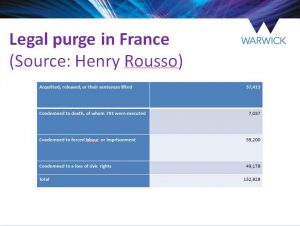
Despite the fact that war crimes in post-war Europe were not restricted to the areas controlled by the Soviets and other Communist regimes, the worst atrocities were indeed committed in Eastern Europe. Western regimes were not immune to human rights violations. After the liberation of France, almost 40,000 people were imprisoned for collaboration and approximately 10,000 people were executed. Compared to other countries, the case of France was atypical and the purge was among the most severe. However, compared to Eastern Europe in general and to the Yugoslav republics in particular, French numbers are extremely small. Researching mass killings, Benjamin Valentino highlighted that ‘the most deadly mass killings in history have resulted from the effort to transform society according to communist doctrine’ because ‘the changes they have sought to bring about have resulted in the nearly complete material dispossession of vast numbers of people’, which means their political and ideological enemies.
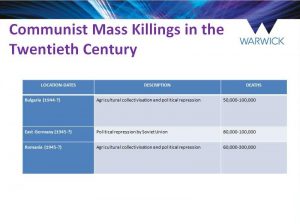 Unlawful killings in Poland and other countries in Eastern Europe were far more widespread than in France. Although ‘The Black Book of Communism’ by Stephen Courtois and his co-authors was the most known attempt to record communist crimes after 1989, they were criticised as not all numbers were reliable. In the Yugoslav case, the authors quoted the number from previous research done by demographers Vladimir Žerjavić and Bogoljub Kočović, stating that ‘rarely in the course of history had the arrival of a new regime been preceded by a bloodbath on the scale of the one seen in Yugoslavia, where out of a population of 15.5 million, 1 million died’. According to the latest available data, in Slovenia, which had a population at that time of between 1,200,000 and 1,300,000, over 14,000 were executed after the war. This shows that repression in Yugoslavia was far more brutal than in Western European countries and was of the same or even higher scale than repressions in countries which were occupied by Soviet troops. Moreover, 73 years after the Second World War, we still don’t know the exact number of the victims of the Yugoslav post-war purges, which means that all numbers historians have been discussing in the past decades are only estimations. There are two main reasons for this: communist crimes itself and war losses in general. I will discuss both of them in details.
Unlawful killings in Poland and other countries in Eastern Europe were far more widespread than in France. Although ‘The Black Book of Communism’ by Stephen Courtois and his co-authors was the most known attempt to record communist crimes after 1989, they were criticised as not all numbers were reliable. In the Yugoslav case, the authors quoted the number from previous research done by demographers Vladimir Žerjavić and Bogoljub Kočović, stating that ‘rarely in the course of history had the arrival of a new regime been preceded by a bloodbath on the scale of the one seen in Yugoslavia, where out of a population of 15.5 million, 1 million died’. According to the latest available data, in Slovenia, which had a population at that time of between 1,200,000 and 1,300,000, over 14,000 were executed after the war. This shows that repression in Yugoslavia was far more brutal than in Western European countries and was of the same or even higher scale than repressions in countries which were occupied by Soviet troops. Moreover, 73 years after the Second World War, we still don’t know the exact number of the victims of the Yugoslav post-war purges, which means that all numbers historians have been discussing in the past decades are only estimations. There are two main reasons for this: communist crimes itself and war losses in general. I will discuss both of them in details.
After the end of the Second World War, historiography focused on the victims of Nazism and Fascism, while communist crimes mostly remained hidden. In Eastern Europe communist crimes could not be researched or publicly discussed as long as communist parties were in power. Questioning official truth offered by the regime meant punishment, such as forced labour, prison or even death. Historians in the democratic part of the World did not have access to Eastern European archives and could not confirm their assumptions with archival evidence. This changed after the end of communism in Eastern Europe when the institutions for collecting data and studying communist crimes were established in Poland, Germany, the Czech Republic, Latvia, Estonia, Hungary, Russia, Lithuania, Ukraine, Slovenia, Romania, but also Sweden and the USA. This was followed by lustration laws which regulated the participation of former communists in politics and the civil service: in the Czech Republic (1993), Slovakia (1996), Hungary (1994 and 1996), Albania (1993 and 1995), Bulgaria (1992), Lithuania (1991), Latvia (1995 and 1996), Estonia (1992 and 1995) and Poland (1997).

It was actually a Polish ‘case’ that drew more attention to Communist war crimes. A massacre of 4,400 Polish prisoners of war, executed by the Russian People’s Commissariat for Internal Affairs in the Katyn Forest in Smolensk was one of the first Soviet war crimes perpetrated against the citizens of another state. The remains were discovered by German troops in early 1943. Soviet officials blamed Germans for these killings. At the time when the Katyn massacre was first discovered in 1943, the British government instructed the BBC not to ‘get involved’ in the mass graves controversy but to treat the German story as an attempt ‘to revive the Bolshevik Bogey’; the Katyn story should be treated by implication as false. Since Stalin was a more important ally than the Polish government-in-exile who wanted to find out the truth, it was more comfortable for the British and the Americans to accept the Soviet version of the Katyn massacre and blame the Germans, as well as encouraging the Poles to compromise. However, the Allies showed no desire to raise the subject of Katyn after the Second World War either. Katyn was only the beginning. During and after the war, crimes were committed by communist party all over Eastern Europe.
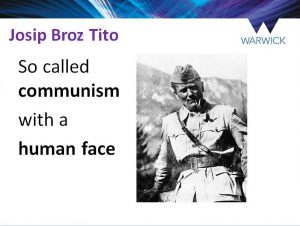
The intensity of violence in Yugoslavia was strongest between autumn 1944 and summer 1945 when mass killings occurred across the country, but repressions were endemic to the very end of Yugoslavia. At the end of and immediately after the war, the KPJ, led by Josip Broz Tito, and assisted by the People’s Liberation Army of Yugoslavia, the Yugoslav Army, the Department for the Protection of the People (OZNA) and the Corps of People’s Defence of Yugoslavia (KNOJ), conducted organized terror not only by intimidation, persecution, torture and imprisonment, but also by the execution of a large number of citizens perceived by the KPJ as disloyal, passive, ideological enemies or class enemies.

The first Croatian region that was under Tito’s attack was Dalmatia where the 8th Dalmatian Corps played a crucial role. The first so-called ‘liberated’ Dalmatian town was Dubrovnik where the 2nd Dalmatian Brigade, supported by the 29th Herzegovina Division, entered on 18 October 1944. Only one day after Dubrovnik was captured, OZNA, for the area under the command of the 8th Corps, sent an order to OZNA for South Dalmatia: ‘you will begin immediately with creating a plan for cleansing your area from pests’.
Apparently, OZNA reacted quickly and in the night of 23-24 October 53 civilians, including the mayor, high school professors, students and priests, were executed on the island of Daksa. The Communists notified the public about the execution on 29 October and claimed that the victims allegedly stood trial on 26 October. One of the most valuable documents about these events is a letter written by Marin Jurjević Baja, secretary of the Regional Committee for KP of Croatia for Dalmatia, on 25 October and submitted to the Regional Committee.
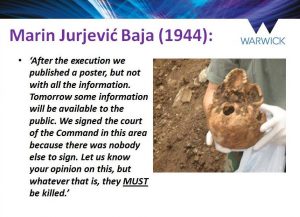
In that letter he stated that 60 enemies of the people, including eight priests, were sent ‘here’ or ‘there’. ‘After the execution we published a poster, but not with all the information. Tomorrow some information will be available to the public. We signed the court of the Command in this area because there was nobody else to sign. Let us know your opinion on this, but whatever that is, they must be killed’, concluded Jurjević. This letter confirms that the victims were indeed executed before the proclamation was announced and the trial, mentioned on the poster, had never been held. It also confirms that the decision about the execution was made by the KP and it was based on simple logic: they had to die.
According to the report, submitted by OZNA for Southern Dalmatia and dated 22 November 1944, the situation in the area of Dubrovnik was described as ‘anarchy’. There were situations when it was necessary to defend people from the Yugoslav Army due to inhumane treatment, looting and robberies. Arrests were not done properly and some were apparently a result of personal disagreements. The regional OZNA reported that
one person, but probably there were more of them, disappeared without a trace – they were taken by the Partisans…In two nights we executed 50 people, but we published the names of 36…We tried to prevent the beatings of the prisoners in public…we mostly did not announce the names of the executed foreigners who lived in Dubrovnik.
Dubrovnik certainly was not an isolated case. Executions continued all over Dalmatia and in these events the KP played a vital role. Based on several documents, that I found in the State Archive of Split, and dated between May and August 1944, it can be concluded that the communists prepared lists (so called ‘black books’) of those who ‘must be killed’ in advance. Another document, found in the same archive, testifies not only about the role the KP had in executions, but also about the power it had over the military courts. According to that document, on 9 August 1944, the Regional Committee of the KP of Croatia for Sinj notified the Military Court of the area under the control of the 8th Corps how to treat the prisoners who were already arrested and for each person they stated if it would be ‘convenient’ to kill them or not. On 22 October 1944, the KP in Makarska notified OZNA about 15 people who ‘deserved to be executed’.
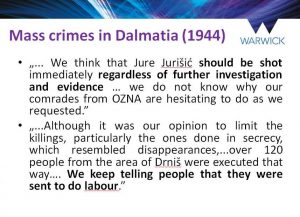
In some cases the KP was unsatisfied with OZNA, whose actions were not decisive enough. For example, on 12 December 1944 the KP for the Biokovo-Neretva region wrote to the KP for Dalmatia that in order to carry out the execution, OZNA asked for more concrete evidence against Jure Jurišić, one of their prisoners. The local KP admitted that they had none, but ‘we think that Jure Jurišić should be shot immediately regardless of further investigation and evidence…we do not know why our comrades from OZNA are hesitating to do as we requested’. On 23 December 1944 the KP for Knin informed the KP for Dalmatia about the killings in Northern Dalmatia: ‘Although it was our opinion to limit the killings, particularly the ones done in secrecy, which resembled disappearances,…over 120 people from the area of Drniš were executed that way…. We keep telling people that they were sent to do labour’. Also, the brutality of the Partisans who participated in the Knin operation was confirmed by the OZNA report dated 13 April 1945, in which it was underlined that “during the battle near Knin an intelligence officer of the Division…stated that he could not interrogate a single prisoner two days although enemies were captured in huge numbers. In the area where he was, and while the battle was still in progress, the prisoners were taken several meters from the road, on a side, and executed without being interrogated first”.

Fewer documents are found about the fate of those who were captured, but allowed to live. On 21 February 1945, OZNA for Knin reported that living conditions in the POW camp set up by a local Command were disastrous. OZNA complained that, “it is more similar to a torture chamber than a camp….Conditions are inhumane. We warned the Command about this, but they did nothing to improve the situation. We believe that this problem should be solved in order to use the labour force better, to rebuild our country. Also, in the case of the arrival of the Allied commission this would leave a bad impression about us as barbarians”.
It seems that the situation in all Dalmatian towns was very similar in the first days after the so-called ‘liberation’. Another report confirms that the Partisans and the KP worked very closely, that they informed each other in detail about the situation in the field, that they knew about the mass killings but they were not completely satisfied with OZNA’s efficiency because they expected larger number of executions.
OZNA also complained about a certain level of anarchy among the Yugoslav soldiers and for political reasons it wanted to prevent public overexposure to public beatings and killings because people were getting scared and the fear could have pushed them further from the Partisan movement. That does not mean that OZNA was against mass killings. Moreover, it was unsatisfied with its own performance because the executions were not carried out immediately.
Once the Knin operation was completed, the 8th Corps started with the operations for capturing Herzegovina, where in January and February 1945 a larger number of war crimes against the civilian population, including Catholic priests and nuns, was committed. Shortly afterwards, the Partisans continued with the preparations for the so-called final operations for the liberation of Yugoslavia which officially started on 20 March 1945. In spring that year they captured entire Croatian region of Lika and town of Gospić.
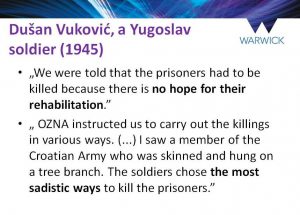
A valuable testimony was preserved about these events. Dušan Vuković, at that time a member of the 1st Battalion of the 8th Brigade (20th Dalmatian Division), stated that the Yugoslav soldiers were allowed to do with the prisoners whatever they wanted. Not all Yugoslav soldiers participated gladly in these executions, but their commanders insisted on it. According to Vuković, the soldiers were told that the prisoners had to be killed because ‘there is no hope for their rehabilitation’. He also testified that “OZNA instructed us to carry out the killings in various ways. Often people’s heads had been smashed with stones and the bodies had been placed into the ruins of the buildings in order to leave an impression that they were killed there. Several kilometers from Gospić some people were thrown into caves. I saw a member of the Croatian Army who was skinned and hung on a tree branch. The soldiers chose the most sadistic ways to kill the prisoners. In my opinion, we executed up to 400 citizens of Gospić”.

Several weeks later and following the surrender of the German capital of Berlin to the Soviet Army on 2 May 1945, the Croatian government decided to flee to Austria where the Croatian Army was supposed to surrender to the British Army advancing north from Italy. The Croatian capital Zagreb was evacuated on 7 May and the following day the city was captured by the First and the Second Yugoslav Army. The First Army reported to the General Staff that 10,901 enemy soldiers had been killed and 15,892 captured in taking Zagreb. In the area of Zagreb, a number of mainly transit camps were organized. Most of them could not accept a growing number of prisoners, which is why many prisoners were held in the open, such as the one in Maksimir.
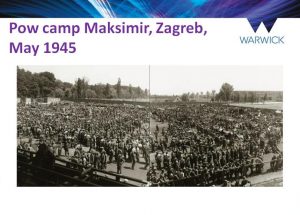
The camps were surrounded by barbed wire. Outside, civilians gathered, brought food and looked for relatives and friends. Between 8 and 15 May 1945, over 20,000 people had already been imprisoned in the two main camps in Zagreb – 7,000 in Kanal and 15,000 in Prečko. The other two bigger camps were Jankomir and Maksimir, as well as the one in nearby Sesvete. The fact that new neighbourhoods were built in these areas of Zagreb after the Second World War means that the exhumation of mass graves that could have been there is basically impossible. In the vicinity of Zagreb, there are a number of mass graves and execution sites. However, one particular case drew the biggest attention when another member of KNOJ, Branko Mulić, publicly confessed his involvement in the executions that took place in Žumberak, a region in the mountains between Samobor and Novo Mesto in Slovenia.
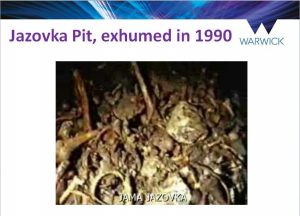
In 1990 Mulić testified that in May 1945, when the Yugoslav Army entered Zagreb, he was sent to OZNA headquarters where he attended a meeting and where he Mulić ordered to prepare a bus for a ‘special task’. In the morning he drove to the Holy Spirit Hospital where wounded members of the Croatian Army were loaded. They were taken to the Jazovka pit near the village Sošice and executed. During speleological research conducted in June 1990, human remains were indeed found in the pit. Damage on the skulls confirmed Mulić’s claims that the victims were shot in the head, but it seems that some of them were hit with a heavy object. Because of its configuration, for those who somehow survived, it was impossible to escape from the pit. It is unknown how many people in total were thrown into Jazovka, but among them are 220 members of the Croatian forces captured after the battle of Krašić in 1943. Anthropological research, conducted in 1999, identified the remains of at least 447 victims. Apart from military and personal belongings, medical equipment, such as crutches and a thermometer were also found. This is why researchers believe that wounded soldiers and hospital staff were among the victims.
I started researching this topic in the State Archives in Zagreb in 2008 where I found hospital documents which revealed that hundreds of soldiers were released from the hospital on 6 and 7 May 1945 because their condition was good enough to retreat with the rest of the Croatian Army. Many who suffered from severe injuries had to stay behind. The records also reveal that among them were soldiers from Germany, Poland, the Czech Republic, Algeria, Morocco, Tunisia, Slovenia, Italy and the New Siberia region who were, according to the record, ‘transferred to another hospital’ on 14 May 1945. So far no research has been conducted about their fate. However, my research did confirm that between 26 May and 11 June at least 109 wounded from the Holy Spirit Hospital were taken to Prečko camp.
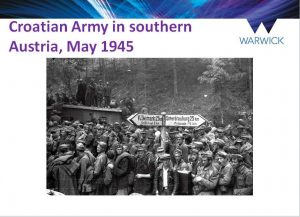
Meanwhile, on 9 May 1945, the Slovenian towns Maribor and Ljubljana were captured by the Yugoslav Army and General Alexander Löhr, Commander-in-Chief of German Army Group E, signed the total surrender of the German forces. These events obstructed the progress of the Croatian soldiers and civilians fleeing towards Dravograd. The Croats negotiated with the Bulgarian Army to allow them to pass into Austria, and the Bulgarians suggested for them to go in the direction of Austrian town of Bleiburg, where the 38th (Irish) Infantry Brigade headquarters was set up. The rest of the British 5th Corps was stationed in Austrian town of Klagenfurt.
It is difficult to estimate how many people were in the columns, because the Croats were not the only troops moving towards the Austrian border. On the move were also thousands of Serbs, Montenegrins and approximately 35,000 Russian Cossacks. Shortly after midnight on 13 May, the British 5th Corps Headquarters estimated that there were approximately 30,000 POWs, surrendered personnel, and refugees in Corps area. A further 60,000 reported moving north to Austria from Yugoslavia. On 14 May, Brigadier T.P. Scott, commander of the 38th (Irish) Brigade received reports that two groups of the Croatian Army, numbering 200,000 in total, were moving towards the British line at Bleiburg, and they were apparently escorting an estimated 500,000 civilians.
It is impossible to say how many Croats actually reached Bleiburg. Between 7 and 15 May 1945, military conflicts were in progress across Slovenia and it remains unknown how many people lost their lives or were captured there. According to available data, on 12 May, 15,700 POWs were captured in Maribor, Zidani Most, Bled, Jesenice and elsewhere, while over 40,000 POWs were taken near Rogaška Slatina, Celje, Velenje, Šoštanj, Dravograd and other Slovenian towns on 13 May. On 14 and 15 May, the Battle of Poljana, near Prevalje, took place. This battle and the so-called Georgian uprising on the Dutch island of Texel which ended on 20 May 1945, are often considered to be the final battles of the Second World War in Europe.
However, it is less well known that the last battle on European soil was in fact the Battle for Odžak, a small town located in northern Bosnia. Despite the lack of archival documents, it can be concluded that the final battle for Odžak, began on 3 May 1945 and it probably ended on the 27 or 28 of May, almost two weeks after the surrender of the Croatian Army at Bleiburg, Austria. Groups of Croatian defenders managed to break through enemy lines. Some retreated into the forest, and others were captured and imprisoned in concentration camps and prisons. Over one thousand POWs were taken to mass executions at ten or more locations in northern Bosnia.
While fighting in Odžak was still in progress, the head of the advancing Croatian column arrived in the meadows just south of Bleiburg on 15 May 1945. The Croatian commander, General Ivan Herenčić, together with his interpreter Colonel Danijel Crljen, drove up to Bleiburg castle, where they attempted to negotiate surrender on terms with Brigadier Scott. However, they soon found out that Yugoslav General Milan Basta arrived on the scene and insisted on joining the talks. The Croats told Scott that an ‘emigration of the whole Croat nation’ was taking place, for they decided that it was impossible to live under the communists and wanted him to refer the problem as a political matter to Field-Marshal Sir Harold Alexander, the Supreme Allied Commander in the Mediterranean whose authority extended to Southern Austria. When Scott asked them to which country they proposed to emigrate, they did not know and suggested to ship them to Africa or America. Scott replied that there was no means by which that could be done and a transfer could only take place after careful preparation. He warned them they would undoubtedly starve if they insisted on coming to the West, but they replied that starving was far preferable to surrendering and that they ‘would rather die where they were, fighting to the last man, than surrender to any Bolsheviks’.

Knowing that the Yugoslav Army was ready to attack the Croats, Scott had no choice but to offer the Croats five minutes to choose one of three options:
- They would surrender to the Yugoslav Army and he would use his influence to ensure that they would be treated correctly.
- They stay where they were and be attacked by the Yugoslav Army.
- They endeavor into British lines, but in that case the British and American air and land forces would also attack them.
General Herenčić reluctantly accepted the surrender terms and the Croats surrendered to the Yugoslav Army However, even if the Croatian request at Bleiburg was presented to Field-Marshal Alexander, the outcome would not have been any different. Alexander was aware that the British forces in Austria, consisting of approximately 25,000 soldiers, were not able to handle such a large number of the refugees. When Scott’s report about 200,000 people surrendering to the British Army in Austria reached Alexander, on 16 May he allegedly issued the following instruction to Air Vice-Marshal Lee, his military emissary at Tito’s headquarters:
We should like to turn over immediately to Marshal Tito’s forces and would be grateful if Marshal Tito would agree to instruct his commanders to accept them and to arrange with GOC Five Corps the rate at which they can be received, and handing-over point on Austrian frontier south of Klagenfurt for return to Yugoslavia.
The following day, on 17 May, Brigadier Toby Low of the 5th Corps issued the order to hand over all Yugoslav nationals in the Corps area to Tito’s forces as soon as possible. The instructions were not to tell them their real destination and it was expected that the handover would last over a longer period. This decision affected thousands of Serbs, Slovenians, and Croats who had already found refuge in the Klagenfurt area thinking they were safe and this led to the events known as the Kočevski Rog massacre which is one of the best documented mass crimes mentioned in my book.
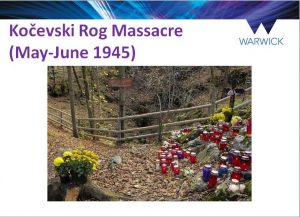
Kočevski Rog is a common term used for a larger number of mass grave locations, possibly ten, in Kočevski Rog forest, but so far only four have been identified. Everyone who was taken to this location was already sentenced to death. Ivan Gugić estimated that several thousand Slovene nationalists, Croatians, Montenegrin Chetniks and members of three Serbian Volunteer Corps regiments were killed there. Among them were also women who were raped before execution, as well as around 200 members of the Ustasha youth movement aged between fourteen and sixteen. The exact numbers of victims in Kočevski Rog probably measures in the thousands, but Simo Dubajić, a member of the Yugoslav Army who participated in these atrocities, claimed that around 30,000 people were executed. Only a few survived, ran away and notified their political representatives in Austria who reported the massacre to the Allies.

On 5 September 1945, John Addis of the Foreign Office’s Southern Department wrote to the British Embassy in Belgrade describing the handing over of the prisoners to Tito as ‘a ghastly mistake’ and saying: “There is little doubt that there was an extensive and indiscriminate slaughter of the Yugoslav quisling troops. And it is distressing to think that they were passed across the frontier by British troops”.
In early November 1945, J.R. Colville, a British civil servant, wrote that “since the incident was a disgraceful one the War Office should be asked to have inquiries made into the immediate responsibility for handing over to a certain and unpleasant death these unfortunate Croats, while the question of their disposal was still under consideration on a high level…I think we can do no more than admit that a serious blunder did take place and that the story does not reflect well on the officers immediately concerned. It is no use trying to hush up an incident which is indefensible”.
As I said earlier, it is unknown how many people gathered in Bleiburg and, therefore, it is impossible to estimate how many were actually killed there. The overwhelming majority of Croatian people returned to Yugoslavia from Austria were not killed at Bleiburg itself, but following their re-crossing of the Drava River, although in collective memory these events are still known as ‘Bleiburg’ or ‘Bleiburg and the Stations of the Cross’.
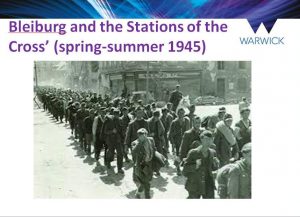
Many victims, including women and children, were assembled in groups and tied two by two with telephone wire. Some were marched through cities and publicly humiliated and tortured. The prisoners were given neither food nor water by their Partisan guards, and were often stripped of any valuable items. When gaps in the column opened up, those at the rear were ordered to run to catch up. To encourage them to move faster, those who lagged behind were often shot without warning. Those who tried to escape were considered fair game. Those who were no longer able to walk due to illness or old age were shot. According to many eyewitnesses, sometimes people were singled out at random, for example because they were tall. Conditions on these death marches, which lasted for days, weeks or even months, were indeed brutal. Many prisoners on death marches were taken by train and trucks, or on foot, into isolated woods, disused mine pits or trenches, and shot in the back of the head or slaughtered; the pits were later mined and covered. In some areas, victims were thrown into caves or forced to dig their own graves. Eyewitnesses spoke of naked bodies hanging from trees, with their eyes, hearts, tongues, arms and genitals cut, murdered mothers with children, bodies of young girls with their breasts cut, and priests and nuns taken from the column. Although death marches continued through Bosnia and Herzegovina to Montenegro and through Serbia to Macedonia, details about these events are mostly unknown because the documents in the archives are rare or not available.
Research on the victims who lost their lives while on these death marches is nearly impossible. So far no lists of those who surrendered have been found, and therefore, there is no data to compare with the lists of the POWs in the cases where they were at least partially saved in the archives. This means that any attempt to calculate how many people lost their lives on death marches would be pure speculation based on testimonies of those who somehow survived. What makes the research more complicated is the fact that many pregnant women were in those columns. Some were killed, and others gave birth along the roads and then they were executed together with their newborns.
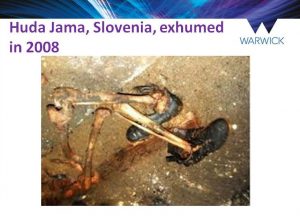
Mass executions were performed without trial or investigation, and the repression was particularly harsh between the end of May and the end of July 1945. According to one of the most prominent Yugoslav communists Milovan Đilas, Tito saw this as a ‘pragmatic solution’ since he feared the courts could not cope with so many individual investigations. ‘The easy way out was to have them all shot, and have done with the problem’, confessed Đilas in an interview published in a British magazine in 1979. Executions became so common that Tito supposedly said, ‘nobody is afraid of death anymore’.
Despite this, concentration and labour camps were full. According to data, in 1946, a year after the war, there were 62 camps in Croatia only. Most had been set up by local police, with Soviet advice and guidance of some kind, such as the one in Jasenovac where the commander of the POW camp in 1946 was Anatolij Avramov, probably of Russian origin. Apart from testimonies provided by survivors, not many official documents have been found regarding the living conditions in those camps. Documents kept in the National Archives in London reveal that the British Red Cross in Graz was informed about the conditions in the prisoners’ camps in Slovenia. In August 1945, they received a letter from Mrs. Kupnik whose husband was imprisoned in one of the camps. She testified about poor diet, starvation, illness, disastrous sanitary conditions, lack of care for pregnant and nursing women, sexual harassment of young girls, and beatings. In September, the Allied Commission for Austria reported that they had received four more reports on conditions in the Yugoslav concentration camps in Slovenia which showed that conditions appeared to be going from bad to worse. Shortly afterwards, the Foreign Office wrote back saying that ‘we have suggested to the Americans a joint approach to the Yugoslavs demanding that these camps be opened to inspection by the International Red Cross’.
The cleansing operation in Yugoslavia continued in later years and by 1947, according to official data, KNOJ units had captured, killed or wounded 116,000 Ustasha, Chetniks and other ‘members of bands’ or ‘enemy groups’. However, the full extent of repression in Yugoslavia and the exact number of victims remains unknown. Cleansing affected all parts of society. Many men and women were victims of a politically motivated policy of revenge and they were accused of Fascist felonies when their major crime was membership of the wrong national or social group, association with an inconvenient religious community or political party, or simply an awkward visibility or popularity in the local community.
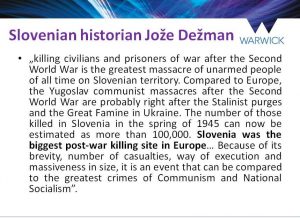
Discussing communist crimes in Slovenia, Slovenian historian Jože Dežman says that “killing civilians and prisoners of war after the Second World War is the greatest massacre of unarmed people of all time on Slovenian territory. Compared to Europe, the Yugoslav communist massacres after the Second World War are probably right after the Stalinist purges and the Great Famine in Ukraine. The number of those killed in Slovenia in the spring of 1945 can now be estimated as more than 100,000. Slovenia was the biggest post-war killing site in Europe… Because of its brevity, number of casualties, way of execution and massiveness in size, it is an event that can be compared to the greatest crimes of Communism and National Socialism”.
Research conducted in the last two decades proves that the number of victims would be much higher than some scholars estimated. Slovenian historian Jerca Vodušek Starič warned that the losses among the Croat population as a whole will probably turn out to be higher than estimated and the death toll that can be attributed to the immediate post-war killings is likely to be, by percentage, among the highest in Europe.
The extent of the cleansing operation and the manner in which it was organized leaves no doubt that the mass murder was carefully planned and executed by the Yugoslav Army and OZNA, but the major issue is: were they ordered by the top Yugoslav politicians and commanders, including Tito? Slaughter in Yugoslavia was extremely well organized and would not have been possible without an element of central organization by authorities high up the Partisan chain of command. Numerous documents confirm that killing of prisoners of war at the end of and immediately after the Second World War was widespread and mostly with impunity. Moreover, two documents imply that the executions were actually carried out by the orders of top ranked communists.
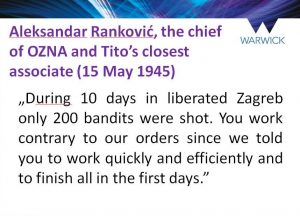
The first one is a dispatch from Aleksandar Ranković sent on 15 May 1945. He expressed his dissatisfaction with the work of the Croatian OZNA stating that; ‘during 10 days in liberated Zagreb only 200 bandits were shot. You work contrary to our orders since we told you to work quickly and efficiently and to finish all in the first days’. Another one is a letter from 25 June 1945, while mass executions were in progress, Edvard Kardelj sent to Boris Kidrič, encouraged him to speed up the ‘cleansing’. Some data suggest that the orders to purge faster came directly from the Yugoslav dictator Josip Broz Tito. On 25 May 1945, Tito celebrated his birthday in Zagreb and the following day he went to Ljubljana where he gave a statement that “as for those traitors who exist in every nation, among all the people, they are now a matter of the past. The hand of justice, arm of revenge of the people reached the majority; only a minority of traitors managed to escape and placed themselves under the protective wing of foreign powers”. That same day, according to Simo Dubajić, he reported to Tito and informed him of the captured prisoners. It seems that on 27 May Tito spoke to Ivan Matija Maček, commander of the Slovenian OZNA, in private. Shortly afterwards, Dubajić received a written order to execute the prisoners in Kočevski Rog. It was signed by OZNA commanders Ivan Maček, Maks Baće and Jovo Kapičić. The question is: Was that decision made at the Tito-Maček meeting? Captured Serbian soldiers remembered that while they were held in the POW camp Šent Vid, the commander of the Serbian OZNA Slobodan Penezić visited the camp and brought Tito’s order about the executions. Another member of OZNA, Zdenko Zavadlav, testified that the order came from the top and was clear: ‘To kill the enemies without trial because the revolution is still going on’.
And indeed, the revolution was going on. The collected documents clearly show, that during the execution of mass crimes and other forms of repression against the defeated enemies, the commanding Partisan officials were not led by irrational revenge, but by the rational attempt to eliminate political opponents in order to achieve complete power. A radical purge of living enemies was not enough. On 6 June 1945, Vicko Krstulović, minister of internal affairs of the Federal State of Croatia ordered the removal of military cemeteries of German, Italian, and Hungarian soldiers, as well as Croatian soldiers. Dead enemies and their graves had to be destroyed too.
However, the communist authorities denied for decades that any of these crimes had ever taken place and stopped all attempts to reveal them. Between 1945 and 1990, in Yugoslavia hundreds of books and papers were published about the Second World War. They contained information about Yugoslav military units and their operations, but without revealing anything about the destiny of POWs or about the killings and repressions that followed the military operations. Any public discussion of communist war and post-war crimes and human rights violations was suppressed, and it means a prison sentence or even death.
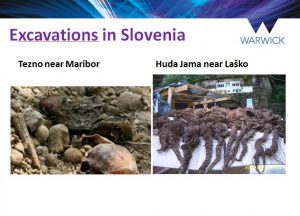
In Slovenia, the first former Yugoslav republic that joined the European Union, intensive research has been conducted since 2003. The Commission’s work is documented in a book published in 2008 which included dozens of photographs taken during the excavations and papers written by archaeologists, anthropologists, historians, forensic scientists and other experts. By October 2009, the Commission on Concealed Mass Graves had identified 581 mass graves where approximately 100,000 victims were buried, among them 50,000 to 80,000 Croats. By January 2011, this number increased to 594. One of the most infamous Slovenian mass graves is the Barbara Pit near Huda Jama in the Laško area. Investigation of the Barbara Pit began in August 2008. On 3 March 2009, investigators removed concrete walls built after the Second World War used to seal the cave. Behind the walls between 200 and 400 mummified bodies were found. The victims, among them women, were buried alive. By 7 November 2009, 726 bodies were removed from the site, but it is speculated that this site could be the grave of 12,000 victims. The results of this research informed the ‘Reports and Proceedings’ of the European public hearing on Crimes Committed by the Totalitarian Regimes. This public hearing was organized by the Slovenian Presidency of the Council of the EU and the European Commission and discussed how the knowledge and public awareness of these crimes can be improved and how reconciliation could be achieved.
In former Yugoslav republics Bosnia and Herzegovina, Macedonia and Montenegro, the authorities have not made any attempts to investigate post-war communist crimes. Following the Slovenian example, a similar Commission was founded in Serbia in 2009. However, the work of both commissions was limited to locating the mass graves and listing the victims, and did not include an attempt to identify the perpetrators that could have led to the interrogation or possible prosecution of still living perpetrators.
Following the Croatian Declaration of Independence in 1991, several attempts were made to identify the victims of the Communist regime and locations of mass executions. Hundreds of books were published. However, most of them took the information from testimonies and only listed the victims without revealing where the information came from. Other books told the story of military units and discussed the involvement of communist organizations in war crimes, but they were mostly based on previously published sources from the Croatian State Archives. The information was inconclusive and sometimes inaccurate, as many sources kept in other archives and museums in Croatia and Slovenia had not been used.
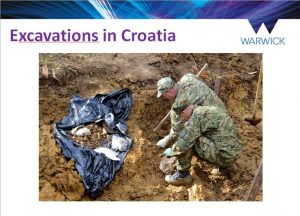
On 8 October 1991, the same day that the Croatian parliament cut all remaining ties with Yugoslavia, the Commission for the Identification of War and Post-War Victims was founded. The law defined war victims as people killed between 6 April 1941 and 9 May 1945. Post-war victims were those killed after that date. The Commission began its work on 11 February 1992 and submitted the report in October 1999 stating that it had collected 88,800 testimonies, recorded the names of 153,700 victims in Croatia, 99,228 in Bosnia and Herzegovina and 8,487 in other republics. The commission identified approximately 700 mass graves in Croatia, including 106 in the City of Zagreb and Zagreb County, as well as 90 mass graves in Bosnia and Herzegovina and 200 in Slovenia. The Commission did not have the time to finish its work as its activities were terminated on 28 May 2002. However, the Commission adopted the same methodology as previous commissions and, as a result, the flaws were identical. Once again archival collections, especially those in regional archives and museums, were ignored.
Following the Resolution 1481/2006 of the Council of Europe Parliamentary Assembly that strongly condemned ‘the massive human rights violations committed by totalitarian communist regimes and expressed sympathy, understanding and recognition for the victims of these crimes’, and the Declaration on the Condemnation of Crimes Committed during the Communist Totalitarian Regime in Croatia between 1945 and 1990, the Croatian State Attorney’s Office initiated the research project ‘War crimes committed against Croatian citizens at the end and after the Second World War’. The Croatian State Archives were asked to prepare a list of the groups of POWs and civilians captured by the Yugoslav Army and Yugoslav authorities. The list should have also included the names of those detained in camps. The project should have collected the following information for each group: composition, formation, movement, locations, separation from or merging with other groups, the circumstances of the surrender and capture, executions of and other atrocities against the group. Based on extensive archival research, the investigators had to systematically investigate and document the sites of mass graves and to assess the reliability, integrity and usability of the collected data and documents related to the victims and potential perpetrators, including an analysis of the needs and possibilities for further research. The data was entered into the database and a separate full report with all the available data and professional analysis was submitted for each grave site that had been investigated. Moreover, between 2008 and 2011 two researchers, including myself, reviewed thousands of documents in more than 30 archives and museums. We prepared 11 case studies, (including information on the sites of the mass graves, the chronology of events, a list of witnesses and victims, and exemplary testimonies), for the Croatian State Attorney’s Office. We wrote additional reports for the Croatian Ministry of Culture and Zagreb Police Department. Unlike previous reports, our reports also contained detailed information about the perpetrators of the crimes – individuals and military units which were at the scene when the crimes happened. However, the research was stopped in April 2011 due to funding problems and a lack of administrative and political support.
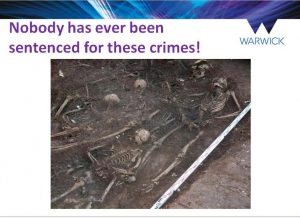
At the same time when the research was conducted, Simo Dubajić, who confessed in his memoirs that he had participated in the killing of at least 13,000 Croatian prisoners of war in May 1945 in Slovenia, was prosecuted for war crimes by the Zagreb County State Attorney’s Office. Zagreb County Court issued an international arrest warrant for Dubajić who at that time lived in Belgrade, Serbia, where he died in July 2009.
In November 2011, another prominent member of the KPJ Josip Boljkovac was arrested. He had served with OZNA and was under investigation for his role in the Second World War and post-war Croatia. According to the former Croatian president Stjepan Mesić this was actually‘a culmination of the right-wing offensive… which is also a glove thrown in the face of today’s Europe’. Following the appeal to the Constitutional court, the charges against Boljkovac have been revoked due to procedural error. Mesić was satisfied and concluded that the arrest ‘undoubtedly harmed the reputation of Croatia among democratic countries’. In January 2012, a new investigation against Boljkovac was launched, but he was not arrested. Boljkovac was finally acquitted of all charges in May 2014. The judge Tomislav Juriša concluded that ‘it would not be fair if all Communist crimes fall on his shoulders’ and that ‘executions were a political decision…and not arbitrariness of the individual’. So far Boljkovac is the only former member of the Yugoslav Army and the KPJ who was tried in Croatia for the crimes committed in Croatia by the Communist regime.
The research project conducted by the Croatian State Archives remains the only one in Croatia with the primary goal of determining the role of communist organizations and identifying the perpetrators, (military units, as well as individuals), of war and post-war crimes committed against Croatian citizens.
Researching demographic losses of the former Yugoslavia in the Second World War has remained one of the most controversial topics in the modern history of the Balkans. Between 1944 and 1964 three Yugoslav commissions produced lists of war victims. However, these lists included only ‘victims of fascist terror’ and served a political purpose. The victim numbers were not accurate and the circumstances of their death were not made clear.
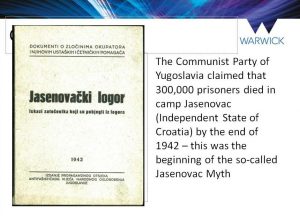
These manipulations started in 1942 when Communist propaganda exaggerated the number of German and Italian victims, trying to motivate people to join their forces. The starting point was the existence of the labour camp Jasenovac in the Independent State of Croatia, founded in the summer of 1941, where, according to a Communist brochure published in late 1942, 300,000 prisoners were murdered. KPJ had no access to the camp and its documentation, and the estimation of the number of victims was based purely on testimonies. Upon the decision of the Anti-fascist Council of the National Liberation of Yugoslavia from November 1943, the State Commission for the Determination of Crimes Committed by Occupiers and their Collaborators was formed, but it focused only on investigating the crimes committed by the opposite side.
The Commission continued its work until 1946 and since then these results have been a starting point of all research on the war crimes committed by the different armies on Yugoslav territory during the Second World War. The Commission published a series of Reports backed-up by a larger number of documents, but these findings have not been questioned or at least double-checked. Its work was affected by political and ideological reasons and there was a tendency to attribute as many victims as possible to other armies. During the Second World War the Yugoslav territory was divided between Italy, Germany, Bulgaria and Hungary, and the armies of these countries collaborated with other national armies and authorities in that region.
When discussing the number of victims, it is important to remember that these numbers are related to the deaths in the former Socialist Republic of Croatia, and they exclude ‘enemies of the people’, including civilians killed by the Partisans. The territory of the NDH was significantly larger and it included Bosnia and Herzegovina as well as Srijem, but did not include parts of Croatia that were under the control of Italian and Hungarian authorities, such as Istria, Kvarner, parts of Dalmatia, Baranja and Međimurje.
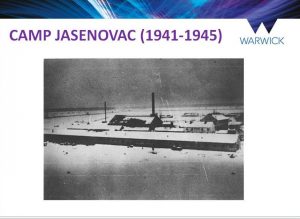
The authorities of the NDH are often linked to different war crimes. However, and given that no objective research has been conducted so far, it is difficult to say how many people were killed. Korb highlights that ‘empirical analyses of collective violence committed in Yugoslavia during the Second World War are still rare’. He states that there is no documentary evidence that a plan of total destruction of the Ustashas’ enemies existed. According to him, Axis interests played an important role in shaping Ustasha policies of violence which were radicalised by the German presence. It was also affected by other events such as counter violence committed by the Partisans or the Chetniks, as well as non-ethnic factors such as national independence being threatened both internally and externally, lack of food etc.
From the very beginning, the authorities of the NDH were expected to support the Final Solution to the Jewish Question. Firstly, the Jews were excluded from public services, and their businesses and property were confiscated. Soon after synagogues were damaged, all this was accompanied by the press and other media with pronounced anti-Jewish articles and speeches. In late June 1941, the movement of Jews was restricted by legal acts and they were forced to wear the Star of David on their clothing. In the summer of 1941, mass arrests of Jews in NDH began, especially in Zagreb. Most of them were sent to the Croatian camps in Gospić, Pag, Jastrebarsko, Loborgrad and Jasenovac. Mass arrests and deportations continued in 1942 and 1943. Although the persecution of Jews in NDH was severe, some of them managed to survive, escaping to parts of the NDH under Italian control or joining the Partisans, while some had been protected by the NDH authorities. Korb underlines that ‘German officials were dissatisfied by the Ustashas’ rather unsystematic persecution of Jews.’ This explains increasing efforts to deport Croatia’s Jews to German death camps in Poland, which was done on a massive scale particularly in the summer of 1942. It is important to emphasize here that the persecution of Jews continued after the war. For example, the remains of the synagogue in Rijeka (Croatia) were destroyed by the communist regime, which also confiscated properties of those Jews who decided to move to Israel.
The major problem the authorities of the NDH faced was a large Serbian population that made over one third of the total population. Between the two world wars Serbs were privileged and their anti-Croatian orientation resulted in numerous persecutions of the Croats. Apart from the radicalization of the ‘Croat question’ since 1929 when King Alexander of the Kingdom of Yugoslavia abolished the Constitution and introduced his dictatorship, these persecutions were another reason why the Ustasha movement, which advocated an independent and sovereign Croatian state, was founded. The less known fact is that in the first days of the Second World War, meaning before the NDH was founded, Serbian soldiers committed war crimes against Croatian citizens, particularly in the area of Bjelovar where at least 20 people were murdered between 8 and 10 April 1941. Ustashas’ actions during the Second World War were to a considerable degree a reaction to the events that had taken place before the war broke out. The Ustasha movement targeted the symbols of Serbian identity prohibiting the use of the Cyrillic alphabet and banning the Serbian Orthodox Church. Instead the Croatian Orthodox Church was founded in 1942. The Serbian population mostly supported the enemies of the newly established Croatian state. The Ustasha movement responded with mass persecutions and deportations to German and Croatian concentration camps. Among them was Jasenovac, a labour and transit camp where allegedly hundreds of thousands were executed.
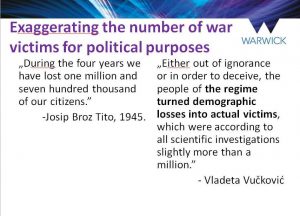
The manipulation of the number of Jasenovac’s victims continued immediately after the end of the Second World War and it served as the most important part of exaggerating the number of war victims in general. On 26 May 1945, Tito suggested that 1,685,000 people were killed during the Second World War in Yugoslavia. However, it is not clear on what information this estimation was based as there had been no population census held after 1931 and the last battle of the Second World War in Yugoslavia took place on 27 or 28 May 1945 in the Bosnian town of Odžak. Nevertheless, Tito repeated the number in July 1945 when he stated that ‘during the four years we have lost one million and seven hundred thousand of our citizens’.
Tito’s statement needed scientific confirmation, but the prominent demographer and Professor Dolfe Vogelnik and his assistant Alojz Debevec refused this assignment since there was no new data on which they could base their calculation. Instead, they decided to pass the task on to Vladeta Vučković, at that time a mathematics student who was working at the Bureau of Statistics in Belgrade. He was given two weeks to calculate the total figure of all victims with the instruction that the number ‘must be impressive, but scientifically-statistically based’. Furthermore, as Vučković emphasized, ‘either out of ignorance or in order to deceive, the people of the regime turned demographic losses into actual victims, which were according to all scientific investigations slightly more than a million.’
That figure of one million people was supposed to include also those killed by Communist forces. Nevertheless, not this number but the number of over 1,700,000 war victims was presented by the Yugoslav representative Edvard Kardelj at the Paris Peace Conference in 1946, the same year when the first official victims’ list was prepared by the Commission for War Damage, and it remained the official number of war victims until the disintegration of Yugoslavia in the early 1990s.
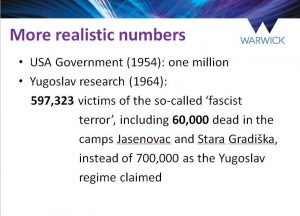
However, based on the number of Yugoslav war victims of one million, provided by the USA government in 1954, Germany refused to pay reparations for 1,700,000 victims. Therefore, the Yugoslav authorities were forced to conduct new research to provide more accurate data. The list of victims was finally completed in 1964, but the result was disappointing since the total number was indeed approximately one million, including 597,323 victims of the so-called ‘fascist terror’. According to the same list, approximately 60,000 people died or were killed in the Croatian camps Jasenovac and Stara Gradiška, where, as the Yugoslav authorities had previously claimed, at least 700,000 people were murdered.
The first, but unofficial excavations in the Jasenovac area were conducted by the municipal committee of former members of the Yugoslav Army from Bosanska Dubica in 1961 at Gradina, near Jasenovac. They found three mass graves and identified 17 human skulls in one of them, but failed to specify the exact number of bones found in the other two. Based on this finding, they counted 120 more undiscovered graves and concluded that the number of victims in Gradina only should be 350,800.
Official forensic investigations, conducted in 1964 in Jasenovac, were supposed to prove huge numbers of victims at Jasenovac, and Yugoslav war victims in general, but were interrupted. After investigating 130 locations, only seven mass graves which held a total of 284 human remains had been found. However, it is important to emphasize that the report, signed by Dr. Alojz Šercelj, stated that ‘a large amount of objects shows that the victims were brought directly to the bridge where the executions took place and they were not previously being held in the camp. On this he is particularly keen to indicate the presence of knives, rings, coins, etc.’ Therefore, the remains found did not belong to the prisoners from Jasenovac camp, but most likely to refugees, possibly Croatian soldiers and civilians who, fearing for their lives, fled the country in May 1945, but were surrendered to the Yugoslav Army by the Allies. The available data and the testimonies encouraged the on-going debate among Croatian historians that this camp continued to exist after the end of the Second World War and it could be a place where communist executions of Croatian POWs took place in 1945 and later. Documents of the Yugoslav provenance, (local authorities, secret police and others), found in the State Archive in Sisak and used for the first time in my published paper ‘Postwar Concentration camp Jasenovac: Witness Testimonies and Newer Archival Sources’ prove that this camp did indeed exist between 1945 and 1948, and possibly longer.

The research results in 1964 with ‘only’ 597,000 war victims shocked the Yugoslav authorities and the list was declared top secret. It remained unknown to the public until 1989 when it was mentioned for the first time in the magazine Danas. The authors of the published article emphasized that, when the first phase of compiling the list was over in October and November 1964 together with the preliminary collection of data at the republic level,
a real panic occurred when this data was put together in the federal commission in Belgrade. The witnesses of those happenings claim that the reactions basically came down to the following phrase: ‘Impossible!’ The lists therefore were returned to the republic commissions and from there to the local level. Here and there minor corrections took place, but the general picture could not be changed.
According to them, it was considered that the error in the compilation of data occurred due to the migration of the population and perishing of whole families and smaller villages in the mountainous regions. However, this could count for approximately one third of the total number.
According to the victims’ lists in the Croatian archives, created by the above-mentioned commissions, it is obvious that the researchers did not examine all available archival documents or even provided the list of source(s) for each victim. Although these lists are a valuable source for researching demographic losses in the former Yugoslavia during the Second World War, they should be used with caution because serious mistakes undermine the reliability.
Another valuable source are unofficial lists prepared by different organizations, controlled by the Communist regime, particularly by the Yugoslav State Security Administration (abbreviated UDBA – Uprava državne bezbednosti) and its’ forerunner OZNA. My previous research in the state archives in Split and Sisak showed that the local authorities also prepared additional lists of the missing, dead and living ‘enemies’ for every village and town in the late 1940s and 1950s. Even though the lists are incomplete, they demonstrate that the Yugoslav government knew the approximate number of all war victims. Moreover, the sources indicate, that occasionally victims of communist repressions were presented to the public as victims killed by the German, Italian or Croatian Army. Lists of living ‘enemies’, including entire families, were also produced. These people were deprived of their political and civil rights, and often their property was confiscated.
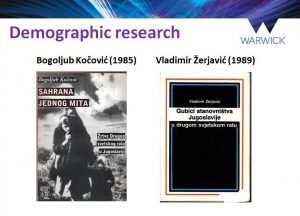
The first population census after the war was held in 1948 and, according to the results, the Yugoslav population had increased two million compared to the census conducted in 1931. Since there was no census in 1941 or 1945, the results of the demographic research, including those published by Serbian researcher Bogoljub Kočović (1985) and Croatian researcher Vladimir Žerjavić (1989), were inconclusive. Moreover, there were several problems related to the census conducted in 1931 that made further research even more difficult. Inhabitants were grouped by their first language and religion instead of nationality, and republican borders were different from those established after the Second World War.
Kočović and Žerjavić both concluded that the number of war victims was approximately one million, as Vladeta Vučković and the USA government had estimated. Žerjavić also suggested that approximately 80,000 people were killed in Jasenovac. However, the major flaw in their research was the fact that they had not conducted in-depth research in the archives. Therefore, the results failed to reveal more information about the composition of victims or the circumstances of their deaths. Kočović emphasized that ‘there is a deeply-rooted opinion, I would say a myth, that at least one million, if not more, Serbs were killed […], that the Serbs were practically the only ones who suffered real losses’. This is particularly important because an inaccurate number of Yugoslav victims killed during the Second World War was used as one of the tools of Serbian propaganda during the Croatian War of Independence (1990-1995).
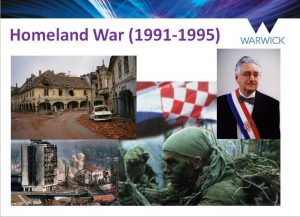
The topic started to draw a great deal of attention in the late 1980s, on the eve of the Homeland War in Croatia, not only because of the previously mentioned article published in the magazine Danas, but also because of the book Wastelands of historical reality published by the Croatian historian and first president of Croatia Franjo Tuđman. The author also analysed the use of the Jasenovac camp as a foundation of the hypothesis of the supposedly genocidal nature of Croats, and he demonstrated how the number of victims of Jasenovac had increased slowly, but surely. According to Anto Knežević, the author of the book ‘An Analysis of Serbian Propaganda’ published in 1992, ‘it is significant that the polemics about Tudjman’s book coincided with the time when Croatia was seeking international recognition of its independence’ in the early 1990s. Knežević emphasized that ‘the attacks are an expression of those international forces which strove to postpone the international recognition of Croatia. These attacks have been carried out by non-historians’. The author stated that ‘Tudjman systematically and with thorough documentation demolishes the myth of the collective guilt of any people’ and concluded that ‘making use of scholarly facts, he questions almost every foundation of the anti-Croatian propaganda that has gone on for many years’ which, according to him, were the main reasons for the attacks on his book.
The number of war victims, especially those who died in Jasenovac, has continued to serve as an important part of anti-Croatian propaganda after the end of the war in 1995. The Serbian web site www.krajinaforce.com commented on the opening of a new memorial in Jasenovac in 2006 stating that ‘massive Croatian Holocaust Revision’ was ‘encouraged’ and that the director of Israel’s office of the Simon Wiesenthal Center, Efraim Zuroff, ‘seemed to accept the scandalous reduction of the number of the people murdered in the Jasenovac death camp complex, leaving an overall impression that Croatia is making steps in the right direction after all’.

The same year the Jasenovac Research Institute (JRI), based in New York, published the book ‘Jasenovac and the Holocaust in Yugoslavia’ edited by Barry M. Lituchy. A year earlier the same organization established the monument for the victims of Jasenovac in New York’s Holocaust Memorial Park which suggested that ‘hundreds of thousands of Serbs, Jews and Roma’ were killed on that location during the Second World War. On JRI’s website, Lituchy claims that ‘estimates of the total numbers of men, women and children killed range from 300,000 to 700,000’ but ‘despite the scale of the crimes committed there, most of the world has never heard of Jasenovac’. Furthermore, JRI representatives emphasize that in October 1991 ‘during the withdrawal, the Croatian Army placed explosives to blow up the bridge on the Sava River which connected the two parts of the Memorial Park; they also blew up the graves, destroyed the Museum artifacts and stole the Museum equipment’, and that due to the courage and enthusiasm of individuals who worked at the Memorial Park, some historical materials and objects were saved.
However, this is not true at all. According to the information of the Memorial Site Jasenovac, the building of the Memorial Museum was prepared for evacuation, but before its contents could be moved to an area outside the war zone, Jasenovac and the Memorial Site were occupied by Serb forces and the Yugoslav Army on 8 October 1991. The museum inventory was transferred to Bosanska Dubica and from there, to Banja Luka which was controlled by Serbian forces. Until May 1995, the Jasenovac Memorial Site was inaccessible to museum staff. In 2000 entire museum inventory was given to the Holocaust Museum in Washington, and from there it was returned to Croatia in 2001.
The approximate number of Jasenovac victims, especially those killed at that location after May 1945 remains unknown. New excavations that might reveal more details related to the structure of victims have not been conducted and the only anthropological data are those from 1964.
In the past two years, researchers Nikola Banić, a member of the Croatian Society of Historians „Dr Rudolf Horvat“ (Zagreb), and his associate Mladen Koić compared data of the Jasenovac victims’ list from the Jasenovac Memorial Center with other databases, including that of Yad Vashem. Their findings have been regularly published by Croatian Weekly magazine, published in Zadar, Croatia, and they are also available at the website www.croatiarediviva.com. The results of their research suggest that numerous individuals amongst the 83,145 people who had supposedly lost their lives at Jasenovac had in fact not been killed at Jasenovac but rather were killed at other locations inside or outside the territories of the former Yugoslavia. Moreover, they proved that many individuals had not even died during the Second World War but in fact had lived long lives after these events and their eyewitness accounts about their experiences during the Second World War can be found on YouTube.

One of these was, for example, Stanko Nick, a Croatian diplomat and a university professor whose name is on the Jasenovac victims’ list although he died in 2010 and his funeral was attended by the current Croatian Prime Minister Andrija Plenković.
This fund of research done by independent experts demonstrated, among other things, that the number officially listed by the Jasenovac Memorial Center site is incorrect. And if so, why does the Jasenovac Memorial Site insist on a number over 80,000 which is the number that Žerjavić suggested? Despite the fact that Banić and Koić have published over 70 papers with a wealth of scientific notations that support their arguments, the former Director of the Jasenovac Memorial Center, Nataša Jovičić, as well as the current Director, Ivo Pejaković, have failed to provide any reasonable explanation for this discrepancy.
They also ignored the findings presented in the previously mentioned paper ‘Postwar Concentration camp Jasenovac: Witness Testimonies and Newer Archival Sources’ despite being asked to update their data. According to Jasenovac Memorial Center in Croatia, there are no documents or witnesses who can confirm that POWs were indeed kept in the Jasenovac camp after May 1945. The buildings of the former Ustasha camp were in ruins, rendering them completely unusable for prisoner accommodation. The group of about 600 prisoners, known as the ‘Sisak Forced Labour Institution – Jasenovac Detail’, was brought from the ‘Sisak Forced Labour Institution’ to Jasenovac and kept there from autumn 1945 until autumn 1947. There were no killings in Jasenovac and the columns of prisoners-of-war returning from Bleiburg did not pass through or stay in Jasenovac.
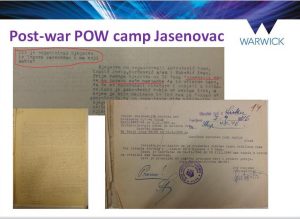
However, all the documents found in the State Archives in Sisak, supported by the documents from the Croatian State Archives in Zagreb, confirm just the opposite. According to these documents, after the Second World War the camp in Jasenovac continued to exist as the POW camp for Croatian prisoners, and later as a forced labour camp under the command of Anatolij Avramov. Documents that confirm that executions took place on that location had also been found. An attempt to escape by one group of Croatian prisoners in August 1946 was also recorded, as well as the killing of one Serbian civilian who was executed by the Yugoslav guards at the front of the camp’s gate.
What is important to emphasize here is the problem of victims of the post-war camp Jasenovac. According to the documents of the State Commission for the Determination of Crimes Committed by Occupiers and their Collaborators, somewhere between 6 May 1945 and 31 May 1946 two police officers of the former NDH – Josip Batarelo and Marko Radić – were executed in Jasenovac. Both names are listed as the ‘victims of fascist terror’. A source for the first killing was a book published in Yugoslavia in 1974 and the source for the second killing was the list of victims from 1964. Not only were the archival sources not used as evidence, but the Jasenovac Memorial Site keeps ignoring them once documents like these are presented to the public. If the victims of the post-war camp Jasenovac continue to be added to the list of those killed in that camp before May 1945, it is not possible to say how many of them actually died in Jasenovac during the Second World War.
Although my paper about POWs camp Jasenovac was published in 2014 and its findings were based on numerous documents found in the archives, the results of that research and existence of the post-war camp Jasenovac has still not been acknowledged by the political elites and some left-wing historians in Croatia. Instead, in the past three years there have been on-going media lynchings of those researchers who continue to research this topic. This example demonstrates how far Croatian society, including official politics, is from coming to terms with the past, particularly crimes committed by the Communist regime. Silence of the institutions responsible for researching this topic opens more space for further manipulations.

The political manipulation and the flaws in previous research had a tremendous impact, even on the generations born after the end of the Second World War. Unlike some other Eastern European countries where communism was installed with the help of the Soviet Army, Yugoslav Partisans had gained power without the help of Soviet troops. The communist government of Yugoslavia was not imposed by a foreign power but was a result of internal factors. This is one of the reasons why the successor states of Yugoslavia have such problems to come to terms with the communist past and why former communists could often continue their careers under now democratic conditions. Former leading members of the communist party still play an important role in Croatian politics and hold positions of power.
The only two former communist countries, and nowadays European Union member states that have not passed lustration laws are the Republic of Slovenia, where they voted against the adoption of such a law at the parliamentary debate in 1997, and the Republic of Croatia, where in 1998 and 1999 the “Proposal of the Law on the Elimination of Consequences of the Totalitarian Communist Regime,” by the Croatian Party of Rights, was removed from the agenda of Parliament by a vote, so they did not even discuss it. As a result, the prosecution of the perpetrators of communist crimes and those who continuously kept violating human rights between 1945 and 1990 remains impossible.

In 2008 I and a Croatian historian Stipo Pilić founded the Croatian Society of Historians “Dr. Rudolf Horvat” from Zagreb with an aim of exploring certain aspects of the process of exposing and coping with the totalitarian communist past and lustration of society. We concluded that a thorough, objective and expert approach to this problem is necessary in order to achieve:
– a true confrontation with the past that burdens Croatian society on a daily basis,
– identification of the historical truth and the progress of Croatian historiography, which has been contaminated with a long-standing ideological and selective approach, and
– the comprehensive protection of human rights and the general democratization of Croatian society. As long as these goals that would enable Croatia’s political, economic, cultural and academic progress are not achieved, the Croatian people will remain “cemented” in the period between the Second World War and the Homeland War, without any hope for a better future unburdened by ideological divisions.
The crossroads upon which Croatia finds herself is tied to her being allowed to deal with her communist past which was officially written by the Communist Party of Yugoslavia with the intent of manipulating primary data, destroying original documentation and inventing motives for their own narratives. Without comprehensive research, which is crucial for unmasking Communist manipulations and propaganda, it is not possible to determine the number of war and post-war victims in the former Yugoslavia, as well as the extent of war and post-war crimes, or to identify the perpetrators and organizers of these crimes. The results of previous research were not only unreliable, but also sometimes contradictory to other sources, which again lead to new manipulations and on-going disputes in Croatian society.
However, due to a reluctance to deal with the Communist past and, incomplete de-communization of Croatian society, all the issues discussed today are still a matter not only of political and scholarly debates, but also of everyday life in Croatia. Questioning total demographic and war losses and investigating communist crimes is often seen as ‘historical revisionism’ in a negative way which is publicly identified as “celebrating Fascism” by the some political parties and media, meaning former communists and their followers. Croatian historians are by no means the only ones whose work is seriously affected by pressure coming from various political circles. Serbian and Slovenian historians have also reported that there is still strong resistance to this kind of research. Those who are preventing scholars from researching this topic know very well that without impartial and thorough research the ‘historical truth’ will keep disappearing behind a politically motivated smokescreen of half-truths, distorted facts and manipulated victim numbers. But, what researchers should remember is that the victims of the events I discussed today are not only those who were slaughtered, but many others whose lives were affected, and even historical science itself. This is why profound changes in Croatian society, and other societies divided by false history facts and wounded by totalitarian regimes in general, are necessary. These changes begin with objective and systematic research because history is indeed life’s teacher.

